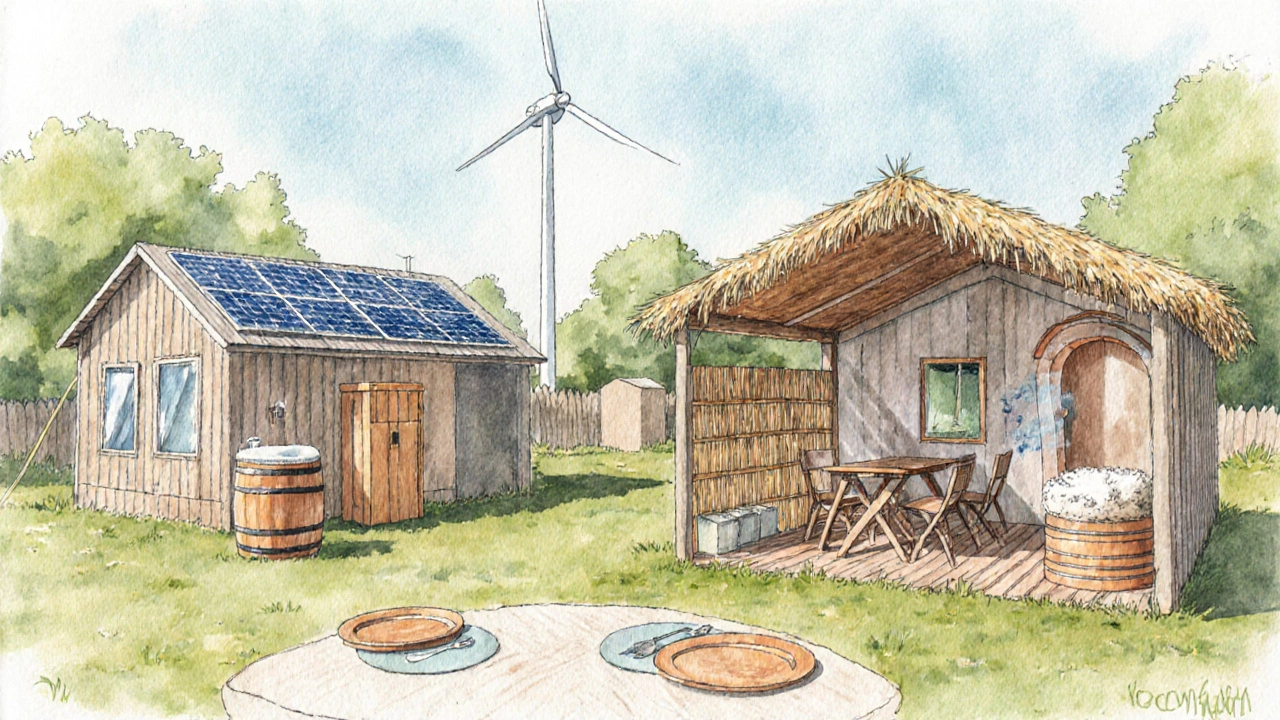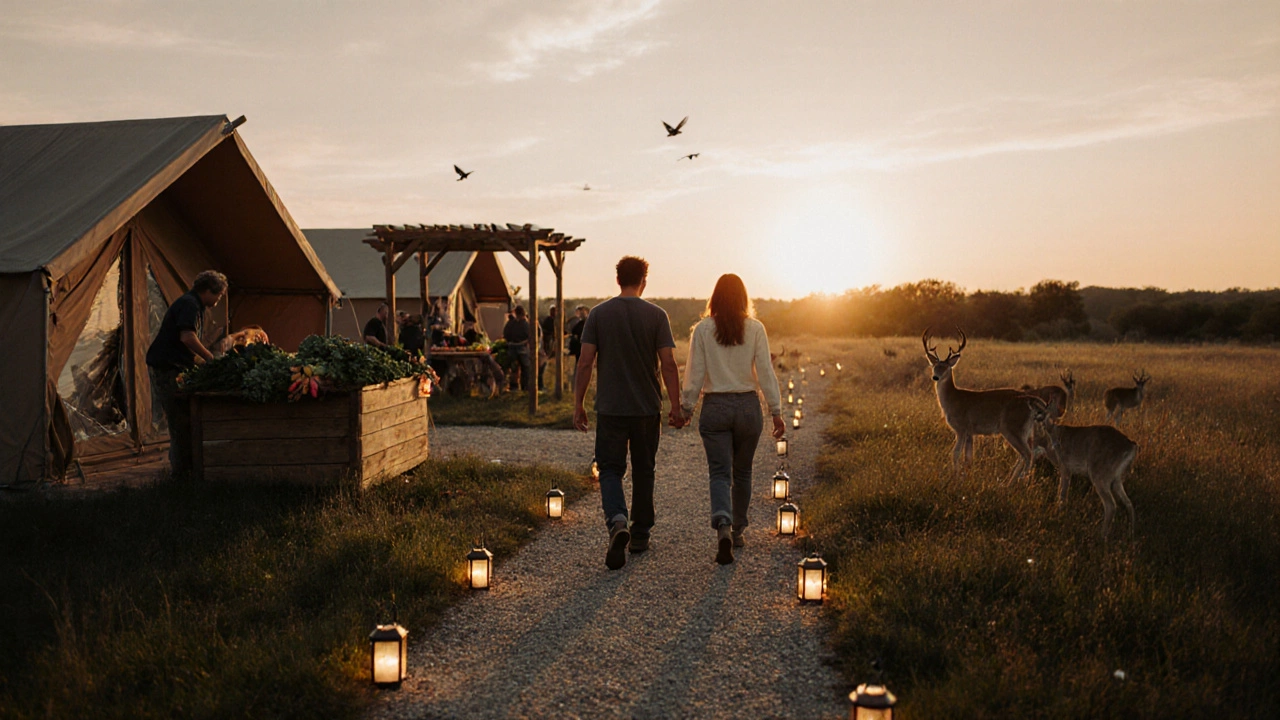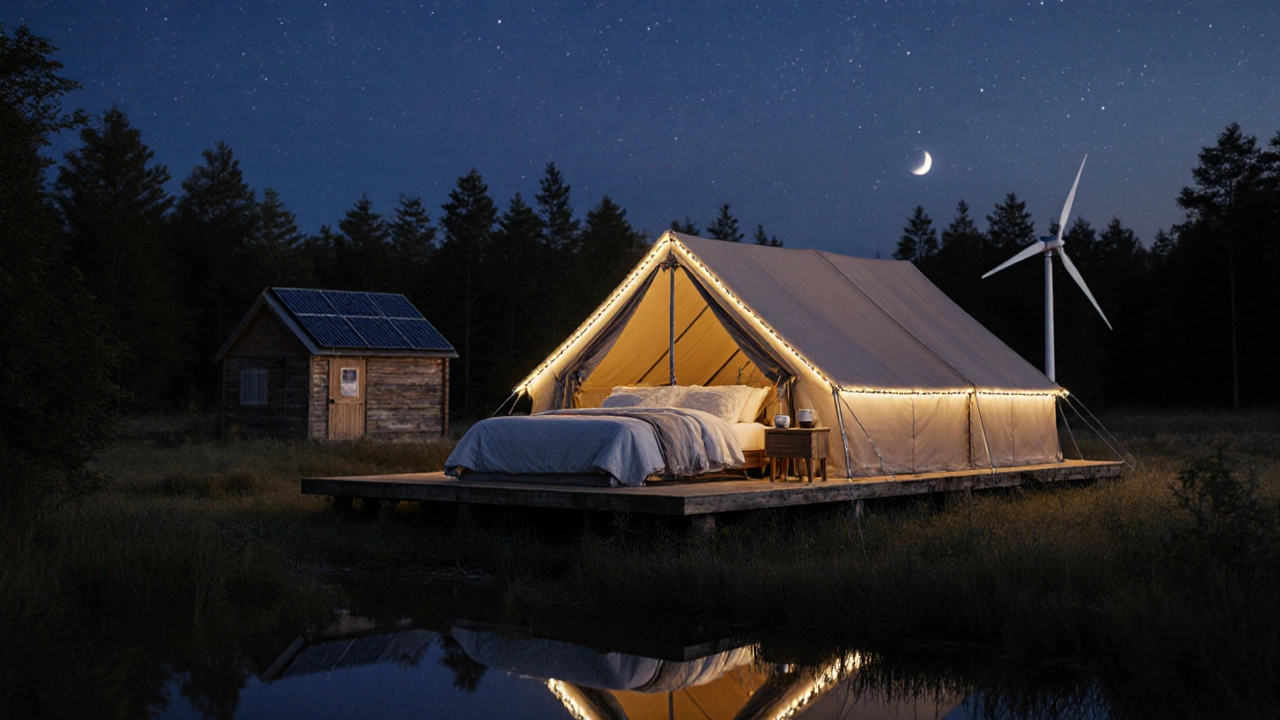Glamping Carbon Footprint Calculator
Compare Your Environmental Impact
See how different accommodation choices affect your carbon footprint during your next trip.
Your Impact Comparison
Sustainability Insights
Choosing glamping with sustainable practices can reduce your footprint by up to 40% compared to traditional hotels.
Based on your trip details, glamping with solar power and local sourcing can save approximately 0 kg CO₂ compared to a standard hotel.
People love the idea of sleeping under the stars without giving up comfort, but they also worry about the planet. The answer lies in eco-friendly glamping - a way to enjoy nature’s perks while keeping the environment happy. Below we break down why glamping can be a greener choice, what practices make it work, and how you can pick sites that truly care about sustainability.
Key Takeaways
- Glamping can cut energy use by up to 40% compared with traditional hotels when it uses solar power and efficient insulation.
- Biodegradable tents, reclaimed wood cabins, and low‑impact foundations reduce land disturbance.
- Local sourcing of food and materials supports nearby economies and trims carbon emissions.
- Many glamping operators offset remaining emissions by planting trees or supporting wildlife projects.
- Choosing sites with clear sustainability credentials lets you enjoy luxury camping guilt‑free.
What Exactly Is Glamping?
When you hear the word glamping is a blend of "glamorous" and "camping" that offers upscale accommodations in natural settings. Think of a fully equipped tent with a comfy bed, a tiny cabin built from reclaimed timber, or a yurt with a wood‑burning stove. Unlike roughing it in a basic campsite, glamping gives you real bathrooms, heating, and sometimes even Wi‑Fi, while still keeping you close to nature.
Why Glamping Can Be More Sustainable Than Traditional Camping
Traditional camping often leaves a heavy footprint: fire pits scar the ground, disposable cookware adds waste, and generators guzzle diesel. Glamping sites designed with sustainability in mind flip that script.
- Renewable energy powers lights, heating and water heating with solar panels, wind turbines, or micro‑hydro systems. A 2023 study of European glampsites found that 68% rely partly on solar, cutting fossil‑fuel use by an average of 35%.
- Low‑impact design uses raised platforms, gravel pads, or prefabricated modules that avoid digging deep holes or trampling vegetation. This preserves soil structure and reduces erosion.
- Water conservation includes low‑flow showers, composting toilets and rainwater harvesting, often cutting water use by half compared with a standard hotel.

Materials That Keep the Land Intact
Choosing the right building materials makes a massive difference.
- Biodegradable fabrics like hemp canvas or recycled polyester are used for tents and awnings, breaking down naturally after their lifespan.
- Reclaimed wood from old barns or shipping pallets gives cabins a rustic look while saving new timber harvests.
- Insulation from sheep’s wool offers high R‑values and is fully biodegradable, reducing reliance on synthetic foams.
These choices cut down on raw resource extraction and ensure that, when a structure reaches the end of its life, it won’t linger in a landfill.
Local Sourcing and Community Benefits
Glamping sites that buy food, furniture and services locally shrink their carbon footprints dramatically.
- Farm‑to‑tent meals cut transport emissions and give guests a taste of regional cuisine.
- Hiring local guides, artists and maintenance staff supports the surrounding economy, often leading to better stewardship of the nearby landscape.
- Revenue-sharing agreements fund community projects such as trail maintenance or wildlife monitoring.
When guests see where their breakfast eggs came from or hear a story from a local elder, the experience feels richer and the environmental impact feels smaller.
Carbon Offsetting and Wildlife Conservation
Even the greenest glamping operation can’t eliminate every emission. Many sites partner with certified offset programs.
- Carbon offset projects such as reforestation in Ireland’s Wicklow Mountains or renewable micro‑grid installations on nearby farms neutralize the remaining footprint.
- Wildlife corridors are preserved or created around glamping sites, allowing native species to move safely and reducing human‑wildlife conflict.
Some operators publish transparent reports showing how many trees they’ve planted or how many hectares of habitat they’ve protected, letting guests verify the impact.

How Glamping Stacks Up Against Traditional Camping and Hotels
| Aspect | Traditional Camping | Glamping | Standard Hotel |
|---|---|---|---|
| Energy Source | Firewood or diesel generators | Solar/wind‑powered + efficient LED | Grid electricity, often fossil‑fuel heavy |
| Water Use (liters per night) | ~50 (portable tanks, showers limited) | ~30 (low‑flow fixtures, rainwater reuse) | ~80 (full‑size bathrooms, laundry) |
| Waste Generation | High (non‑biodegradable packaging, food waste) | Low (compostable toiletries, recycling bins) | Medium‑High (single‑use plastics, landfill waste) |
| Land Disturbance | Often severe (fire pits, tent stakes) | Minimal (raised platforms, no permanent groundwork) | Significant (large foundations, paved areas) |
| Carbon Footprint (kg CO₂ per night) | ~2.5 | ~1.5 (with offsets can be <0) | ~4.0 |
Numbers vary by location, but the pattern is clear: well‑run glamping sites usually sit between low‑impact camping and high‑energy hotels, offering a sweet spot for eco‑conscious travelers.
Tips for Choosing a Truly Eco‑Friendly Glamping Site
- Look for certifications such as Green Globe, Eco‑Label Ireland, or LEED.
- Check if the site publishes a sustainability report or carbon‑offset disclosures.
- Ask about energy sources - solar panels and wind turbines are good signs.
- Inquire whether meals are sourced locally and whether there’s a waste‑reduction program.
- Prefer sites that protect wildlife corridors or contribute to local conservation projects.
When a glamping operator can answer these questions transparently, you’re likely supporting a genuinely green operation.
Frequently Asked Questions
Is glamping really better for the environment than staying in a hotel?
Generally yes, especially when the glamping site uses renewable energy, low‑flow water fixtures and local sourcing. Hotels often rely on centralized heating, large water supplies and more extensive waste streams. A well‑designed glamping experience can cut energy use by up to 40% and water use by about half compared with a typical mid‑range hotel.
Do glamping sites generate a lot of waste?
The best sites aim for zero‑waste policies: biodegradable toiletry items, compost bins for food scraps, and recycling stations for glass and metal. Some even partner with local farms to turn organic waste into animal feed.
Can I camp in a glamping tent without electricity?
Absolutely. Many glamping operators offer off‑grid cabins powered by solar panels with battery storage. Guests can use LED lanterns, USB‑charging stations, and can even bring their own solar chargers if they prefer.
How does glamping protect local wildlife?
Eco‑focused sites design pathways and accommodation footprints to avoid sensitive habitats, maintain wildlife corridors, and limit night‑time lighting that can disrupt nocturnal species. Some also fund local monitoring programs that track bird or bat populations.
What should I pack to stay green while glamping?
Bring reusable water bottles, a stainless‑steel cutlery set, and a cloth bag for groceries. Choose natural fabrics for clothing, and if you use a personal charger, opt for a solar‑powered power bank.
Next Steps: Making Your Glamping Trip Sustainable
Now that you know the why and how, it’s time to put the knowledge into action.
- Research glamping destinations that list renewable energy and waste‑reduction measures.
- Book early - many eco‑certified sites have limited capacity and fill up fast during peak seasons.
- Plan a low‑impact itinerary: hike, bike, or kayak instead of renting fuel‑heavy vehicles.
- Leave a review that highlights the site’s green practices - it helps other travelers make informed choices.
By choosing a site that truly embraces sustainability, you get the best of both worlds: a comfortable night under the stars and the peace of mind that you’re protecting the very environment you love.
